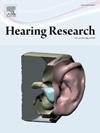Channel crosstalk detected using ECAP measurements is associated with poorer speech perception in cochlear implant users
IF 2.5
2区 医学
Q1 AUDIOLOGY & SPEECH-LANGUAGE PATHOLOGY
引用次数: 0
Abstract
The number and independence of channels in cochlear implants (CI) has long been considered to influence speech recognition, particularly in competing background noise. Measures of channel independence have been obtained via psychophysical and objective means, relying on interactions between probe and masker signals delivered on different channels. In the current study, electrically evoked compound action potentials (ECAP) obtained from 32 Nucleus CI recipients tested at one basal and one apical position were performed using a standard spread-of-excitation procedure. An alternative analysis method, comparing masked responses only, revealed distant maskers as effective or more effective than same-electrode maskers in 13/32 cases. This appears to indicate substantial crosstalk between channels, covering up to nine intracochlear electrodes in one subject. Subjects with atypical responses and no other limiting factors had significantly poorer sentence recognition in noise compared with those with no detected peripheral or cognitive limiting factors. We propose that channel crosstalk detected via ECAPs may be a biomarker for poor or patchy neural survival that leads to poorer speech perception in CI recipients.
使用ECAP测量检测到的通道串扰与人工耳蜗使用者较差的语音感知有关
人工耳蜗(CI)中通道的数量和独立性一直被认为会影响语音识别,特别是在竞争背景噪声下。通道独立性的测量是通过心理物理和客观手段获得的,依赖于在不同通道上传递的探针和掩蔽器信号之间的相互作用。在目前的研究中,电诱发复合动作电位(ECAP)来自32个核CI受体,分别在一个基底和一个根尖位置进行测试,使用标准的兴奋扩散程序进行。另一种分析方法,仅比较掩蔽响应,显示13/32的远程掩蔽器比相同电极掩蔽器更有效或更有效。这似乎表明通道之间存在大量的串扰,在一个受试者中覆盖了多达9个耳蜗内电极。非典型反应和没有其他限制因素的受试者在噪声中的句子识别能力明显低于没有检测到周围或认知限制因素的受试者。我们提出,通过ecap检测到的通道串扰可能是导致CI接受者语音感知较差的神经存活不良或不完整的生物标志物。
本文章由计算机程序翻译,如有差异,请以英文原文为准。
求助全文
约1分钟内获得全文
求助全文
来源期刊

Hearing Research
医学-耳鼻喉科学
CiteScore
5.30
自引率
14.30%
发文量
163
审稿时长
75 days
期刊介绍:
The aim of the journal is to provide a forum for papers concerned with basic peripheral and central auditory mechanisms. Emphasis is on experimental and clinical studies, but theoretical and methodological papers will also be considered. The journal publishes original research papers, review and mini- review articles, rapid communications, method/protocol and perspective articles.
Papers submitted should deal with auditory anatomy, physiology, psychophysics, imaging, modeling and behavioural studies in animals and humans, as well as hearing aids and cochlear implants. Papers dealing with the vestibular system are also considered for publication. Papers on comparative aspects of hearing and on effects of drugs and environmental contaminants on hearing function will also be considered. Clinical papers will be accepted when they contribute to the understanding of normal and pathological hearing functions.
 求助内容:
求助内容: 应助结果提醒方式:
应助结果提醒方式:


